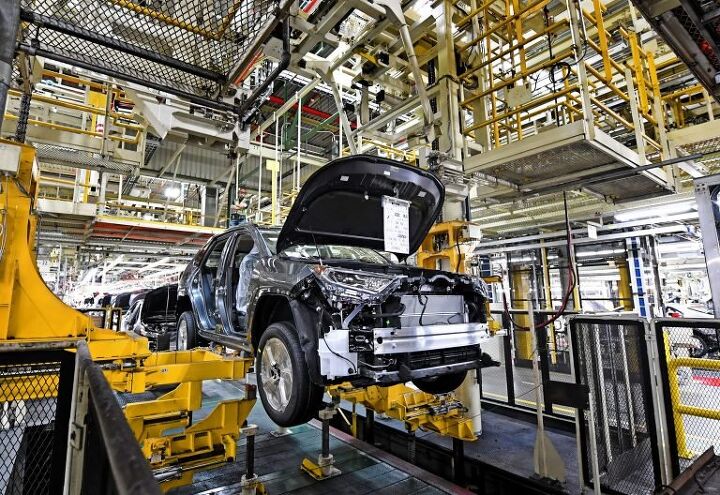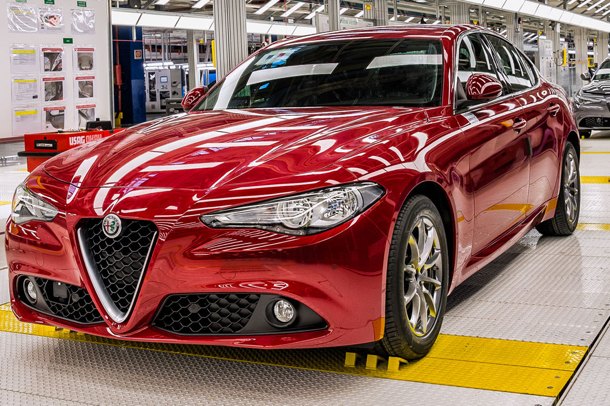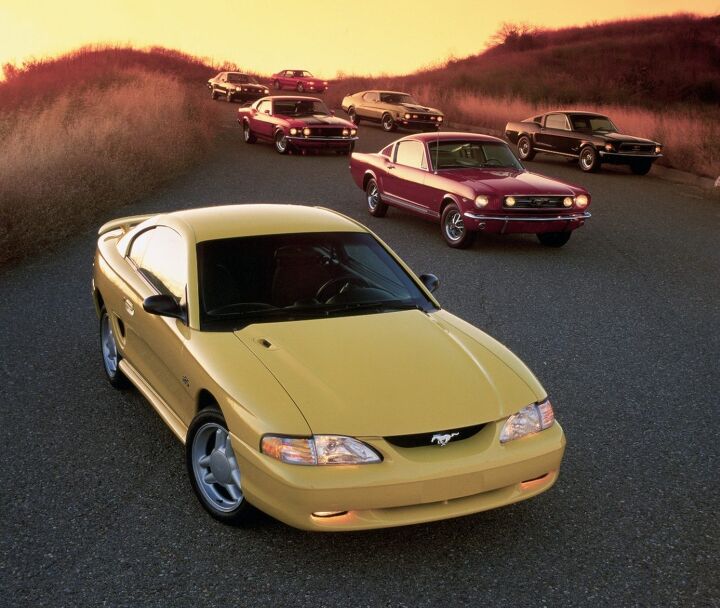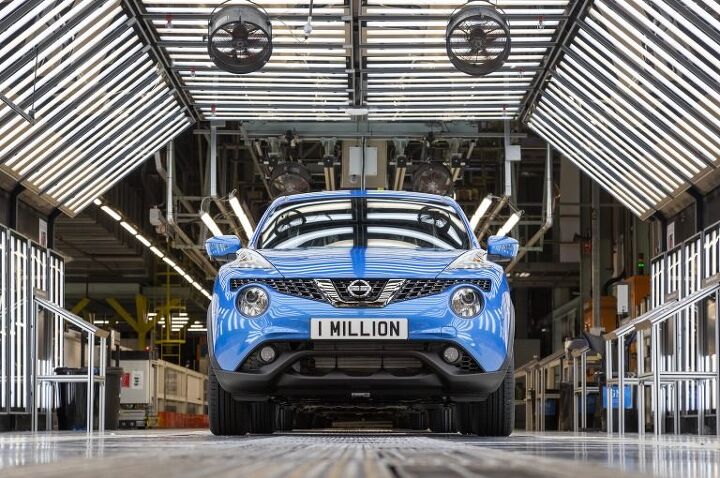#Assembly
GM Hits the Ramp, Accelerates
There’s inventories to be filled with trucks and crossovers, and time’s wasting. After staging a cautious, production-limited restart of its North American assembly plants on May 18th, General Motors is prepared to put its foot down, boosting output at numerous locations.
Hungry dealers can’t wait.
Report: Toyota to Throttle Back Production Through October
Today is Back to Work Day for many North American Toyota workers, with the automaker joining other manufacturers in slowly resuming production following an extended period of pandemic downtime. The process of ramping up won’t be an overnight thing, given considerations related to employee health and market demand.
Indeed, Americans are heading back to dealerships in greater numbers, but Toyota isn’t planning on returning to normal production levels for some time, a source told Reuters. Overall output for the automaker stands to take a major hit.
Easier Said Than Done: Restarting the Automotive Industry
As the global health crisis pivots toward becoming an economic one, the automotive industry is understandably eager to know when it can begin producing cars again. The situation isn’t going to be as easy as throwing open a few breaker boxes and giving the thumbs up. A mile-long list of problems, many of which lack easy answers, will first have to be tackled before things return to normal.
Supply chains will be slow to move — and potentially severed — as other nations wait longer to walk back social distancing measures. Not all factories will resume operation at the same time, and not all parts suppliers or shipping agencies will have made it through the coronavirus pandemic intact. It’s also uncertain how quickly customers will return to the market. In tougher financial times, customers may remain hesitant in making large purchases; meanwhile, localized quarantines will undoubtedly continue suppressing sales in certain markets. Then we have the elephant in the room — the vast amount of money this colossal reboot is going to require.
European Plants Going Dark As Continent Shuts Down
Automakers are doing their best to keep the lights on in Europe as a rapidly spreading coronavirus pandemic disrupts supply chains and sends workers and staff into quarantine. It’s proving to be a difficult task.
As a new week dawns, numerous automakers have announced plant shutdowns, with Europe’s arguably most famous factory on the verge of going dark itself. Fiat Chrysler isn’t even limiting the scope of its shutdown — the majority of its assembly sites in that continent are closed, effective immediately.
Report: Audi E-Tron Production Stalled Over Suspected Battery Shortage
Audi has reportedly paused assembly of its all-electric e-Tron to address production issues that include battery supply bottlenecks. It’s not uncharted territory for the model. Audi had to delay the model’s launch over claimed software changes in 2018, though it was known that corporate parent Volkswagen Group was having trouble with battery supplier LG Chem at the time. Since then, the crossover’s short life has been a well-publicized series of victories and failures.
Outselling rivals like the Jaguar I-Pace by a margin of almost two to one, Audi delivered 5,369 e-Trons in the United States in 2019 despite it not being available for the full year. Competition was closer in Europe, with the Audi still moving in larger volumes. The model also received favorable crash test ratings and was awarded with the IIHS’ Top Safety Pick+ designation.
However, supply problems never really abated. Every few months brought a new rumor that Audi was suffering from battery shortages, possibly forcing it to idle production. A battery fire scare prompted the factory to voluntarily recall the first batch. While the impact of these issues was rarely as serious as feared, their persistent nature caused many to wonder how ready the industry actually is for the transition to EVs.
Roadblocks Gone, 2020 Chevrolet Corvette Kicks Off Production
Delayed by a prolonged UAW strike late last year, General Motors announced Monday that that series production of the 2020 Chevrolet Corvette C8 has begun. The very first mid-engine Stingray intended for the passenger market has left the retooled assembly line in Bowling Green, Kentucky, with many more to follow.
Everything you’ve seen up to this point was technically a pre-production model, though there shouldn’t be any big changes forcing you to cancel your order. It’s still powered by a naturally aspirated 6.2-liter V8 (495 hp, 470 lb-ft) and should run to 60 mph in under 3 seconds if you launch it carefully. Even if you aren’t enamored with the styling and prefer the front-engined C7, the C8 represents both a performance bargain and a major technological leap for the model. GM has teased mid-engined Corvettes for decades; now they’re real.
Market Share: Tesla Model 3 Sees Lower Chinese Pricing
Next week, Tesla Motors will begin deliveries of its Shanghai-made Model 3 to Chinese customers — who stand to get a bit of a deal on them. Unlike Western markets, China is already loaded with local companies manufacturing electric vehicles and Tesla doesn’t want to lose out on market share simply because it priced its vehicles too high.
Originally, the manufacturer intended on selling introductory Model 3s at 355,800 yuan ($51,000 USD) a pop. That was soon lowered to 323,800 yuan ($46,500) to pull shoppers from automakers like BYD, NIO and Xiaopeng Motors. Broad profit margins are nice, but the Chinese EV market is too crowded for the brand not to focus on market share.
Old Kentucky Home: GM Confirms C8 Corvette Production Site, New Emblem
General Motors has officially announced that the Chevrolet Corvette will continue production in Bowling Green, KY after it transitions into a mid-engined car. The automaker will add 400 new jobs and a second shift to support production of the new model, bringing the factory’s workforce to more than 1,300 individuals.
However, the Corvette news — such as it is — doesn’t end there. The vehicle’s factory-sanctioned Facebook page also revealed the car’s new logo on Friday.
Honda Announces Closure of Sole UK Plant
The sole production site of the Honda Civic Hatchback and Type R will close by the end of 2021, Honda told UK employees on Tuesday.
Honda’s Swindon facility, built on the site of a former WW2 aircraft factory, began building Accords for the UK and European markets in 1992, adding the popular Civic to the mix two years later. Amid a turbulent time for trade and auto sales, Honda plans to shutter the facility, throwing 3,500 employees out of work and leaving the future of the Civic Hatch and its variants in question.
A New Alliance? Volkswagen and Ford In Talks to Share U.S. Plants
Months of speculation fueled by the increasingly chummy relationship between Ford and Volkswagen has given way to new possibilities. The two partners, who signed a Memorandum of Understanding earlier this year, might leap further into bed than initially thought.
To hear VW CEO Herbert Diess tell it, the two automakers might soon share American assembly space. And can Tennessee expect a new plant? It’s on the table.
GM Gets EPA Nod for Building the Most Greenwashed Large SUVs on the Market
The Texas plant producing General Motors’ body-on-frame SUVs is clean and green, even if the vehicles it builds are anything but Prius-like.
In August, the 43 turbines of Southern Power’s 148 MW Cactus Flats Wind Facility became operational in Concho County, Texas. GM, along with General Mills (the tastier GM) both have contracts to purchase power from the facility — in GM’s case, some 50 MW of it per year. That means it can now claim its Arlington, Texas assembly plant is 100 percent powered by renewable energy. The Environmental Protection Agency just placed GM at No. 76 on its list of the country’s largest green power users.
It’s amazing the kind of tree-hugging press one can get for a factory that essentially builds dinosaurs.
Panasonic Attempts to Pull Tesla Out of Production Hell
When Tesla Motors began production of its Model 3 sedan, CEO Elon Musk announced the firm was entering into a kind of “ production hell.” He probably didn’t realize just how accurate a statement that would turn out to be. Already contending with a backlog of orders for the Model 3, Tesla simply couldn’t meet the volume targets it set for itself over the last year. It’s now bending over backwards to finish the quarter strong and prove to investors it is capable of turning a profit.
The automaker frequently referenced production bottlenecks as the culprit for the Model 3’s delay. Panasonic, the sole battery supplier for the vehicle, appears to be taking ownership of the issue. “The bottleneck for Model 3 production has been our batteries,” Yoshio Ito, Executive Vice President of Panasonic, said on Tuesday. “They just want us to make as many as possible.”
Mustang Milestone: Ford Has Assembled Ten Million Ponies
You have to wonder if Donald Frey and Lee Iacocca knew what they had when the first Ford Mustang rolled off the assembly line in 1964. Despite having a storied career of dramatic highs and lows, the model has been an overwhelming success, standing the test of time. This week, Michigan’s Flat Rock Assembly is celebrating that history after finishing production on the 10 millionth Mustang to grace this planet.
While this represents a grand achievement for a vehicle that’s undoubtedly an American icon, its sales volume is nothing compared to the mighty Toyota Corolla — which has sold 43 million units worldwide. Still, 10 million cars is incredibly good for any model and exceptional for a performance model. In fact, the Mustang is the best-selling sports car in history and has been for years. For the sake of comparison, Chevrolet has built roughly 5.5 million examples of the Camaro since its introduction in 1966.
Your Ex Is Doing Fine: Nissan Just Manufactured Its One Millionth Juke
The phrase “Nisan just built its one-millionth Juke” would probably be the first question on a Voight-Kampff test for automotive lovers residing in North America. The information is totally incompatible with everything you thought you understood about the world around you, and processing it begins scrambling your brain as you frantically hunt for an escape from it. An open window? The sweet release of death?
Relax. While the news is scary and difficult to comprehend, don’t forget that there is an entire world out there with a populace that’s not subject to the same predilections as ours. The Juke may have been too funky to become a massive hit in the United States and Canada, but it had a few good years and Nissan planted seeds all across the globe.
Japanese sales of the model almost matched the U.S., despite having a comparatively minuscule population. Volume also exceeded expectations in Europe, and China has a weird luxury version of the Juke called the Infiniti ESQ. But it wasn’t a good fit for North America and sales suffered as a result, forcing Nissan to call in the Kicks as the Juke’s successor after annual deliveries started plunging a few years ago.
Chrysler, Dodge Brands' Hazy Future Doesn't Worry Union Boss
For two brands steeped in Americana, Chrysler and Dodge sure seem to love Canada. Two Ontario plants continue cranking out Grand Caravans, Challengers, Chargers, 300s, and Pacificas, even as the 9,600-strong workforce in Windsor and Brampton grow leery of the future.
It’s not just the complete lack of interest Fiat Chrysler displayed in those particular brands during last month’s five-year plan unveiling; it’s also the threat of import tariffs on foreign-made vehicles that could very well sink across-the-border manufacturing.
Nah, it’s all good, says Jerry Diaz, president of the union representing Detroit Three autoworkers in the Great White North.






























Recent Comments